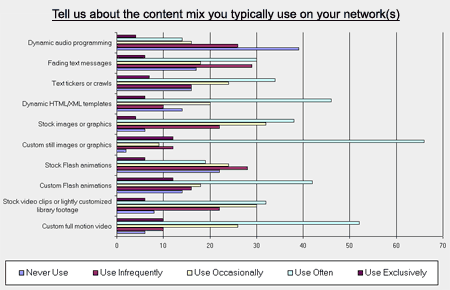What kinds of content do people run on their screens?

While the content mix remains as varied as last year, one pretty amazing change is the decline of screens using custom full motion video. Whereas last year over 16% of respondents reported using custom video exclusively, with another 60% or so reporting they used it frequently, this year only 10% reported using custom video exclusively, with just over 50% reporting they used it frequently. Between the two numbers, that's about a 16 percentage point decrease in custom video use, which seems pretty remarkable to me. Meanwhile, custom image use is up a bit, as is dynamic template use. Thankfully, dynamic ticker use is down.
How much does all this content cost?
One thing we haven't done is a formal analysis of content production costs, partly because it's a giant pain to get arbitrary quotes for imaginary projects, but mostly because we work with so many content production companies that I really don't feel comfortable declaring what content "should" cost, as much of it is very subjective.
That said, during a review of last year's article I did notice a comment from Jim Hickman at a company called VideoBillboard.net (which produces content for digital signage networks), where he explained:
When you speak of digital signage content, our company has some experience designing effective creative messages. Over the past 10 years we have created hundreds and hundreds of custom messages. As far as cost goes the average design time is 5.3 hours and the ads are done in flash and Photoshop of course.I know this is only a single data point. But since nobody has offered up any similar information, and I haven't gone around asking for quotes, I'll use it to illustrate a point: content production doesn't necessarily have to break the bank. This is important, since once you start your digital signage network, you'll have to feed it fresh content pretty much forever. But let's look at what happens to a single spot generated in 5.3 hours at various hourly pricing levels:
| $15/hr | $20/hr | $25/hr | $30/hr | $40/hr | $50/hr | $60/hr | $70/hr | $80/hr |
| $80 | $106 | $133 | $159 | $212 | $265 | $318 | $371 | $424 |
You'll pay varying amounts depending on whether you get your neighbor's friend's kid to make your spots for $15/hr or hire a professional for twice that (or more). But then again, the quality of those two outputs will likely be different too.
What's the future of content?
As we see the use of video fall (and let's face it, five years ago 90% of digital signage networks were probably exclusively using full motion video), something will have to take its place. My guess is that dynamic content will end up filling the void. While Adobe Flash at one point had a stranglehold on that market, dynamic HTML has made a strong showing, and will no doubt become even more prevalent as more digital signage players become capable of displaying HTML 5 content. That said, there's plenty of room left for still images, and various flavors of dynamic text, since the 2011 digital signage content mix appears to be just as varied as the 2010 mix was.
The good news is that as more content becomes dynamically updateable, the overall price of content production should go down, since the expensive bits (like full motion video or 3D) can be generated once, and then altered or repurposed via dynamic controls. And actually, there really isn't any bad news. Over the past year, more content houses have become familiar with the unique presentation challenges of DOOH networks, there have been more educational undertakings to explain how to design effective digital signage content, and more end users are recognizing that you can't simply put up recycled TV commercials and expect to see great results. When you think about it, that's a win for network owners and viewers alike.
What other content trends would you like to see us cover? Leave a comment and let me know!

 Subscribe to the Digital Signage Insider RSS feed
Subscribe to the Digital Signage Insider RSS feed